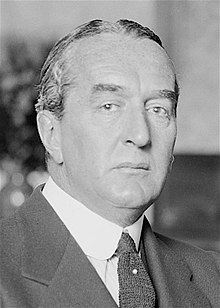
Back ستانلي بروس Arabic ستانلى بروس ARZ Стэнлі Брус Byelorussian Stanley Bruce Czech Stanley Bruce German Stanley Bruce Spanish Stanley Bruce Basque استنلی بروس Persian Stanley Bruce Finnish Stanley Bruce French
The Viscount Bruce of Melbourne | |
|---|---|
 Bruce in 1930 | |
| 8th Prime Minister of Australia | |
| In office 9 February 1923 – 22 October 1929 | |
| Monarch | George V |
| Governors‑General | |
| Deputy | Earle Page |
| Preceded by | Billy Hughes |
| Succeeded by | James Scullin |
| Leader of the Nationalist Party | |
| In office 9 February 1923 – 22 October 1929 | |
| Preceded by | Billy Hughes |
| Succeeded by | John Latham |
| Treasurer of Australia | |
| In office 21 December 1921 – 8 February 1923 | |
| Prime Minister | Billy Hughes |
| Preceded by | Sir Joseph Cook |
| Succeeded by | Earle Page |
| High Commissioner to the United Kingdom | |
| In office 7 September 1932 – 5 October 1945 | |
| Preceded by | Granville Ryrie |
| Succeeded by | Jack Beasley |
| Member of the Australian Parliament for Flinders | |
| In office 11 May 1918 – 12 October 1929 | |
| Preceded by | William Irvine |
| Succeeded by | Jack Holloway |
| In office 19 December 1931 – 6 October 1933 | |
| Preceded by | Jack Holloway |
| Succeeded by | James Fairbairn |
| Member of the House of Lords Lord Temporal | |
| In office 18 March 1947 – 25 August 1967 Hereditary peerage | |
| Personal details | |
| Born | Stanley Melbourne Bruce 15 April 1883 St Kilda, Colony of Victoria |
| Died | 25 August 1967 (aged 84) London, England |
| Political party |
|
| Spouse | |
| Parent |
|
| Education | Melbourne Grammar School |
| Alma mater | Trinity Hall, Cambridge |
| Occupation | Commercial lawyer (Ashurst, Morris, Crisp & Co.) |
| Profession |
|
| Signature |  |
| Military service | |
| Allegiance | United Kingdom |
| Branch/service | British Army |
| Years of service | 1914–1917 |
| Rank | Captain |
| Unit | 2nd Battalion, Royal Fusiliers |
| Battles/wars | World War I |
| Awards |
|
Stanley Melbourne Bruce, 1st Viscount Bruce of Melbourne (15 April 1883 – 25 August 1967) was an Australian politician, statesman and businessman who served as the eighth prime minister of Australia from 1923 to 1929. He held office as the leader of the Nationalist Party, having previously served as the treasurer of Australia from 1921 to 1923.
Born into a briefly wealthy Melbourne family, Bruce studied at the University of Cambridge and played a leading role in his family's softgoods firm following the suicide of his father John Munro Bruce. He served on the front lines of the Gallipoli Campaign in World War I and returned to Australia wounded in 1917, becoming a spokesman for government recruitment efforts. He gained the attention of the Nationalist Party and prime minister Billy Hughes, who encouraged a political career. He was elected to the House of Representatives in 1918, becoming member of parliament (MP) for the seat of Flinders. He was appointed as treasurer in 1921, before replacing Hughes as prime minister in 1923. He established an anti-socialist coalition government with the agrarian Country Party, working closely with Country leader Earle Page in an arrangement that pioneered the modern Liberal–National coalition.
In office, Bruce pursued an energetic and diverse agenda. He comprehensively overhauled federal government administration and oversaw its transfer to the new capital city of Canberra. He implemented various reforms to the Australian federal system to strengthen the role of the Commonwealth, and helped develop the forerunners of the Australian Federal Police and the CSIRO. Bruce's "men, money and markets" scheme was an ambitious attempt to rapidly expand Australia's population and economic potential through massive government investment and closer ties with Great Britain and the rest of the British Empire. However, his endeavours to overhaul Australia's industrial relations system brought his government into frequent conflict with the labour movement, and his radical proposal to abolish the Commonwealth Court of Conciliation and Arbitration in 1929 prompted members of his own party into crossing the floor to defeat the government. In the resounding loss at the 1929 election, Bruce lost his own seat, making him the only sitting prime minister to lose his seat until John Howard's defeat at the 2007 election.
Although he returned to parliament in 1931, Bruce's service in the Lyons government was brief. Instead he pursued an international career, accepting appointment as High Commissioner to the United Kingdom in 1933. Bruce became an influential figure in British government circles and at the League of Nations, emerging as a tireless advocate for international co-operation on economic and social problems, especially those facing the developing world. Particularly passionate on improving global nutrition, Bruce was one of the key figures in the establishment of the Food and Agriculture Organization, serving as the first chairman of its governing council. He was the first Australian to sit in the House of Lords, as well as the first Chancellor of the Australian National University. Although his diplomatic career went largely unnoticed in Australia, he continued throughout his life in London to vociferously advocate for Australian interests (particularly during World War II) and asked that his remains be scattered over Canberra when he died.